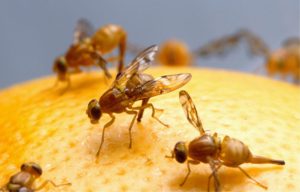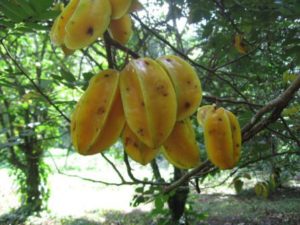Why Protein Bait?
INCREASE YEILD Sustainable Fruit Flies Management.
Fruit flies are the world’s worst fruit pest. They appear on nearly every continent and millions of dollars are spent annually on their control and eradication. The adult females damage fruits and fruity vegetables by laying eggs under the skin, resulting in rotting fruits and premature fruit drops. Commercial growers and small farmers are exposed to lower income if fruit flies are not controlled. It has been estimated that anything up to 80% of fruit and vegetable output is destroyed by fruit fly infestation. Furthermore, commercial growers may suffer trade restrictions imposed by importing countries.
Fruit fly laying eggs.

Fruit fly larvae.

Prima Fruit Fly Bait
- Easy to apply
- Suitable for IPM programmes
- Economical
- Safer to use
- No residue problem for food
- Safer to the environment
How can I control fruit flies and get good fruits?
Control methods commonly used include cover sprays of insecticides, spot sprays of protein baits, orchard sanitization, bagging/netting, early harvesting, sterile insect technique and male annihilation. Some countries do not allow cover sprays of insecticides as it kills beneficial insects and leaves unwanted residues in fruits. It is also expensive and intensive use of sprays in fruit crops can elevate growers’ risk of exposure and the potential for long term effects.
What are Protein Baits?
Fruit flies need sugars and proteinaceous food to survive and mature. They utilize various sources such as microbes, pollen, etc. Protein bates are food substances which attract the fruit flies.
Is there any other type of fruit fly attraction?
Apart from protein baits, there are a group of attractants that are based on fruit fly sex attractant, the para-phesmones. Examples- methyl eugenol. However, these attractants only attract the male fruit flies of certain species only. They are used with traps; as a monitoring tool for early warning; to determine the effectiveness of fruit fly control programmes and for surveillance purposes. These attractants have a greater range of attraction than protein baits.
Are protein baits and trapping the same?
Trapping are used primarily for monitoring purposes, while protein bait sprays are intended for fruit fly control.
How do I use Protein Baits to control the fruit flies?
Spot spraying is the recommended application technique with protein baits. It consists of spraying a solution of protein and insecticide in water to a one square metre spot on the lower canopy foliage of fruit trees or on the foliage along the crop rows. This attracts the female flies, which needs a meal of protein to produce fertile eggs. While feeding on the bait, the fly consumes a toxic does of insecticide. Protein baits sprays are less harmful to beneficial insects, making them suitable for use in IPM programmes.
Because of the spot spraying technique, there is less insecticide applied to the crop or tree and non-target species have more refuge. Costs are considerably lower as less material is used per tree or per hectare. In addition, spot spraying is less time consuming than for cover spraying and therefore less demanding of labour. Farmers may also be able to use simple, inexpensive spraying equipment. Bait sprays are more environmentally sound because of reduced pesticide usage and less risk of spray drift. Spray applications can be directed on to foliage and away from fruit to minimize fruit residue problems. Reduced pesticide usage and use of coarse sprays at low pressure results in fewer hazards to the spray operator.
How safe is Protein Bait?
The protein bait does not contain any toxic pesticides and is safe to users. However, for effective control programmes, a minute amount of approved pesticide needs to be added e.g. malathion at 0.2% strength. Safety to humans is based on the insecticide used. Malathion is comparatively safe to humans.